Understanding Consumer Behaviour and Decision-Making in Hospitality
VerifiedAdded on 2023/01/06
|12
|2719
|1
Report
AI Summary
This report delves into the intricacies of consumer behavior within the hospitality sector, using Claridge's as a case study. It examines the consumer decision-making journey, mapping the path to purchase and highlighting the importance of understanding this process for marketers. The report explores the key differences between B2C and B2B decision-making in hospitality, providing specific examples, and evaluates various market research approaches and methods used to understand the decision-making process. Furthermore, it analyzes how marketers can influence different stages of the decision-making process in relation to hospitality services. The report covers topics such as problem recognition, information search, evaluation of alternatives, purchase decisions, and post-purchase behavior, offering insights into how businesses can tailor their strategies to meet consumer needs and preferences effectively.
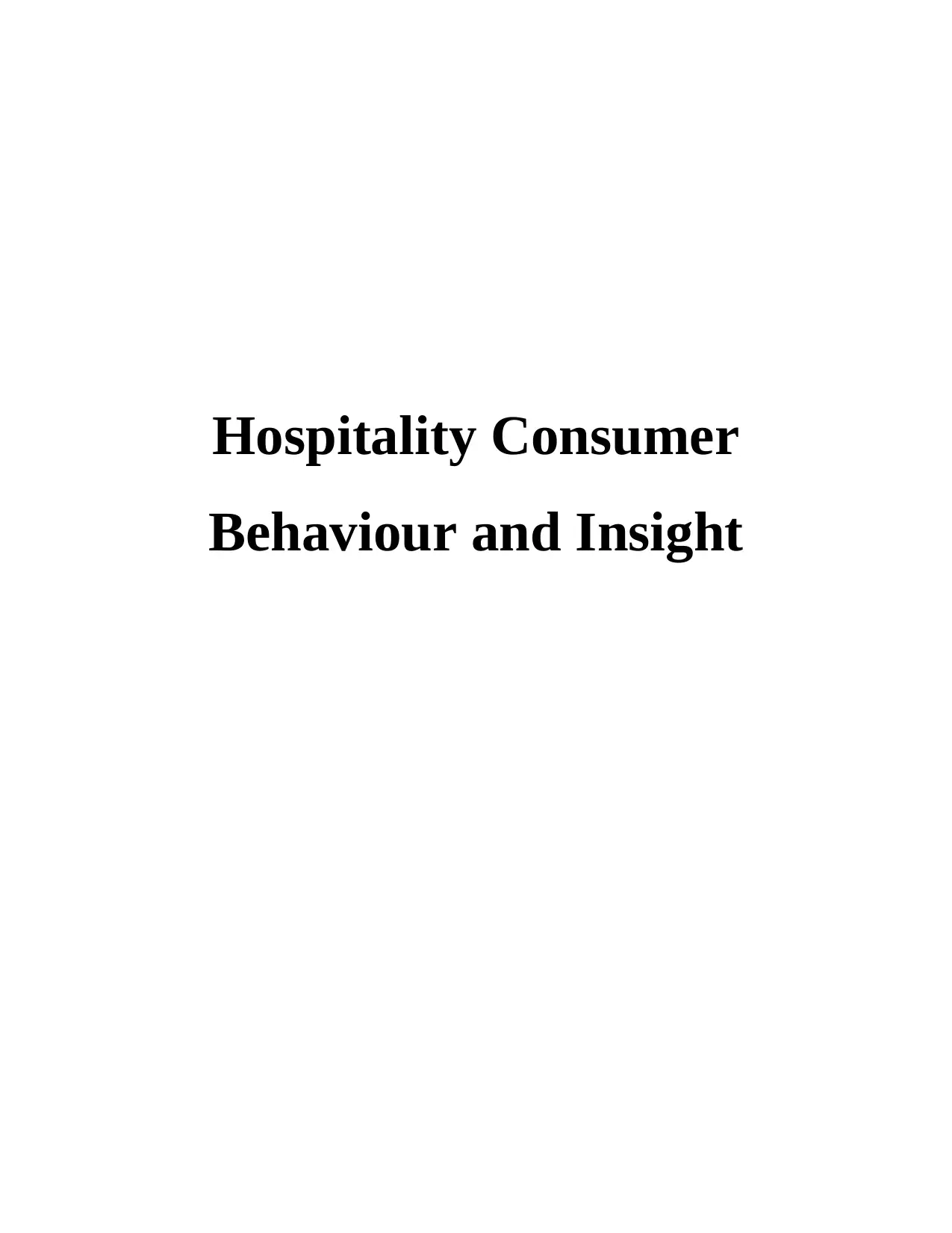
Hospitality Consumer
Behaviour and Insight
Behaviour and Insight
Paraphrase This Document
Need a fresh take? Get an instant paraphrase of this document with our AI Paraphraser
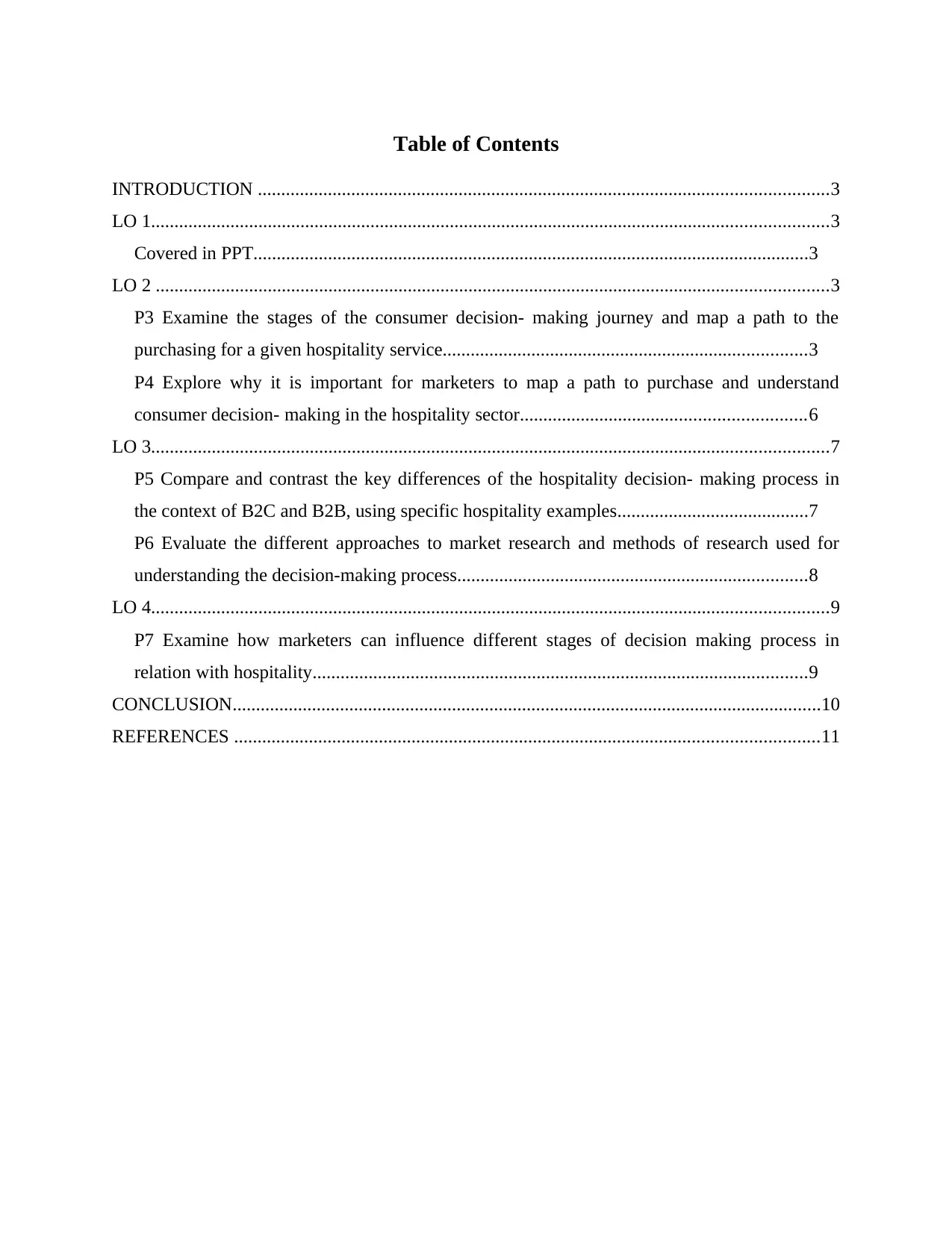
Table of Contents
INTRODUCTION ..........................................................................................................................3
LO 1.................................................................................................................................................3
Covered in PPT.......................................................................................................................3
LO 2 ................................................................................................................................................3
P3 Examine the stages of the consumer decision- making journey and map a path to the
purchasing for a given hospitality service..............................................................................3
P4 Explore why it is important for marketers to map a path to purchase and understand
consumer decision- making in the hospitality sector.............................................................6
LO 3.................................................................................................................................................7
P5 Compare and contrast the key differences of the hospitality decision- making process in
the context of B2C and B2B, using specific hospitality examples.........................................7
P6 Evaluate the different approaches to market research and methods of research used for
understanding the decision-making process...........................................................................8
LO 4.................................................................................................................................................9
P7 Examine how marketers can influence different stages of decision making process in
relation with hospitality..........................................................................................................9
CONCLUSION..............................................................................................................................10
REFERENCES .............................................................................................................................11
INTRODUCTION ..........................................................................................................................3
LO 1.................................................................................................................................................3
Covered in PPT.......................................................................................................................3
LO 2 ................................................................................................................................................3
P3 Examine the stages of the consumer decision- making journey and map a path to the
purchasing for a given hospitality service..............................................................................3
P4 Explore why it is important for marketers to map a path to purchase and understand
consumer decision- making in the hospitality sector.............................................................6
LO 3.................................................................................................................................................7
P5 Compare and contrast the key differences of the hospitality decision- making process in
the context of B2C and B2B, using specific hospitality examples.........................................7
P6 Evaluate the different approaches to market research and methods of research used for
understanding the decision-making process...........................................................................8
LO 4.................................................................................................................................................9
P7 Examine how marketers can influence different stages of decision making process in
relation with hospitality..........................................................................................................9
CONCLUSION..............................................................................................................................10
REFERENCES .............................................................................................................................11
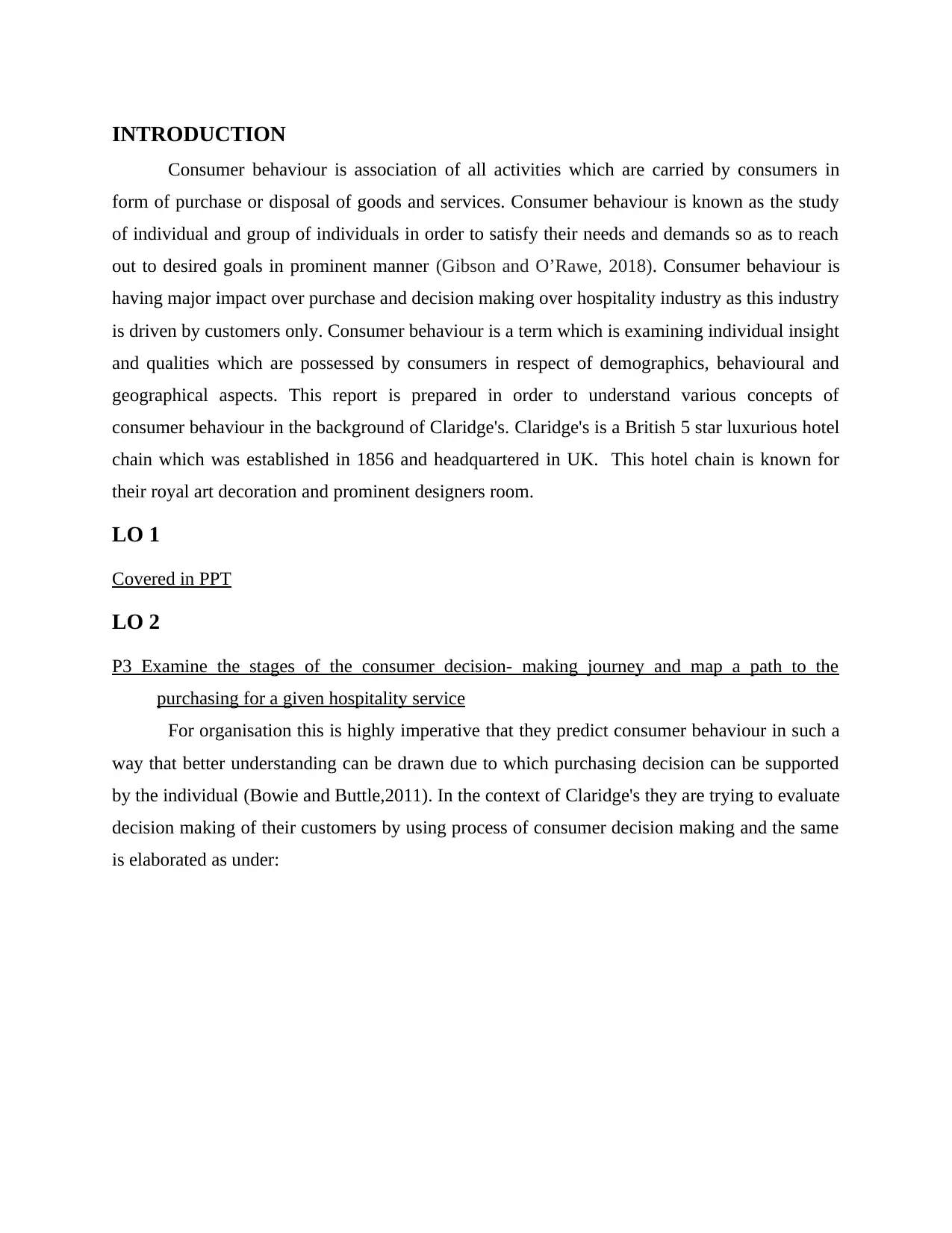
INTRODUCTION
Consumer behaviour is association of all activities which are carried by consumers in
form of purchase or disposal of goods and services. Consumer behaviour is known as the study
of individual and group of individuals in order to satisfy their needs and demands so as to reach
out to desired goals in prominent manner (Gibson and O’Rawe, 2018). Consumer behaviour is
having major impact over purchase and decision making over hospitality industry as this industry
is driven by customers only. Consumer behaviour is a term which is examining individual insight
and qualities which are possessed by consumers in respect of demographics, behavioural and
geographical aspects. This report is prepared in order to understand various concepts of
consumer behaviour in the background of Claridge's. Claridge's is a British 5 star luxurious hotel
chain which was established in 1856 and headquartered in UK. This hotel chain is known for
their royal art decoration and prominent designers room.
LO 1
Covered in PPT
LO 2
P3 Examine the stages of the consumer decision- making journey and map a path to the
purchasing for a given hospitality service
For organisation this is highly imperative that they predict consumer behaviour in such a
way that better understanding can be drawn due to which purchasing decision can be supported
by the individual (Bowie and Buttle,2011). In the context of Claridge's they are trying to evaluate
decision making of their customers by using process of consumer decision making and the same
is elaborated as under:
Consumer behaviour is association of all activities which are carried by consumers in
form of purchase or disposal of goods and services. Consumer behaviour is known as the study
of individual and group of individuals in order to satisfy their needs and demands so as to reach
out to desired goals in prominent manner (Gibson and O’Rawe, 2018). Consumer behaviour is
having major impact over purchase and decision making over hospitality industry as this industry
is driven by customers only. Consumer behaviour is a term which is examining individual insight
and qualities which are possessed by consumers in respect of demographics, behavioural and
geographical aspects. This report is prepared in order to understand various concepts of
consumer behaviour in the background of Claridge's. Claridge's is a British 5 star luxurious hotel
chain which was established in 1856 and headquartered in UK. This hotel chain is known for
their royal art decoration and prominent designers room.
LO 1
Covered in PPT
LO 2
P3 Examine the stages of the consumer decision- making journey and map a path to the
purchasing for a given hospitality service
For organisation this is highly imperative that they predict consumer behaviour in such a
way that better understanding can be drawn due to which purchasing decision can be supported
by the individual (Bowie and Buttle,2011). In the context of Claridge's they are trying to evaluate
decision making of their customers by using process of consumer decision making and the same
is elaborated as under:
⊘ This is a preview!⊘
Do you want full access?
Subscribe today to unlock all pages.

Trusted by 1+ million students worldwide

Problem recognition: This is the most prominent stage under consumer decision making
journey as without identification of problem and recognition of needs. This step is related with
recognising area and need for the product or services which is helpful in meeting standards and
performance criteria as well.
Information search: Under this stage various information is being searched by taking assistance
of different sources. For example if a customer is willing to book a hotel room then he will seek
information from many hotels and look after to their quotations along with service quality and
efficacy. This is an external approach under which numerous aspects are being checked by
customer to make their purchase decision (Dixit, 2017).
Evaluation of alternatives: This is the third stage within consumer decision making process
under which various brands are evaluated by them on the basis of different attributes in order to
meet their purpose. This is a very crucial stage under which customer is comparing various
brands according to their criteria and the brand is most suitable for them can be selected by them
as this is fitting within their needs and demands (Carlos Hidalgo,
2018).
journey as without identification of problem and recognition of needs. This step is related with
recognising area and need for the product or services which is helpful in meeting standards and
performance criteria as well.
Information search: Under this stage various information is being searched by taking assistance
of different sources. For example if a customer is willing to book a hotel room then he will seek
information from many hotels and look after to their quotations along with service quality and
efficacy. This is an external approach under which numerous aspects are being checked by
customer to make their purchase decision (Dixit, 2017).
Evaluation of alternatives: This is the third stage within consumer decision making process
under which various brands are evaluated by them on the basis of different attributes in order to
meet their purpose. This is a very crucial stage under which customer is comparing various
brands according to their criteria and the brand is most suitable for them can be selected by them
as this is fitting within their needs and demands (Carlos Hidalgo,
2018).
Paraphrase This Document
Need a fresh take? Get an instant paraphrase of this document with our AI Paraphraser

Purchase decisions: Under this stage purchase has already been took place as in this stage
customer is inclined towards their needs and those product and services which are suitable to
them in sufficient manner. Within this stage consumer has already evaluated all the alternatives
and value has been examined by them. Purchase decision get influenced by social media, crowd
leads, recommendation and many other aspects.
Post purchase behaviour: Post purchase behaviour is defined as the manner by which customer
are given reviews after using product or services. This is known as the manner by which
customers are expressing their happiness and level of satisfaction. This aspect is having high
implications over future purchases of the customer from that particular brand or organisation
(Simon Kemp, 2017).
customer is inclined towards their needs and those product and services which are suitable to
them in sufficient manner. Within this stage consumer has already evaluated all the alternatives
and value has been examined by them. Purchase decision get influenced by social media, crowd
leads, recommendation and many other aspects.
Post purchase behaviour: Post purchase behaviour is defined as the manner by which customer
are given reviews after using product or services. This is known as the manner by which
customers are expressing their happiness and level of satisfaction. This aspect is having high
implications over future purchases of the customer from that particular brand or organisation
(Simon Kemp, 2017).
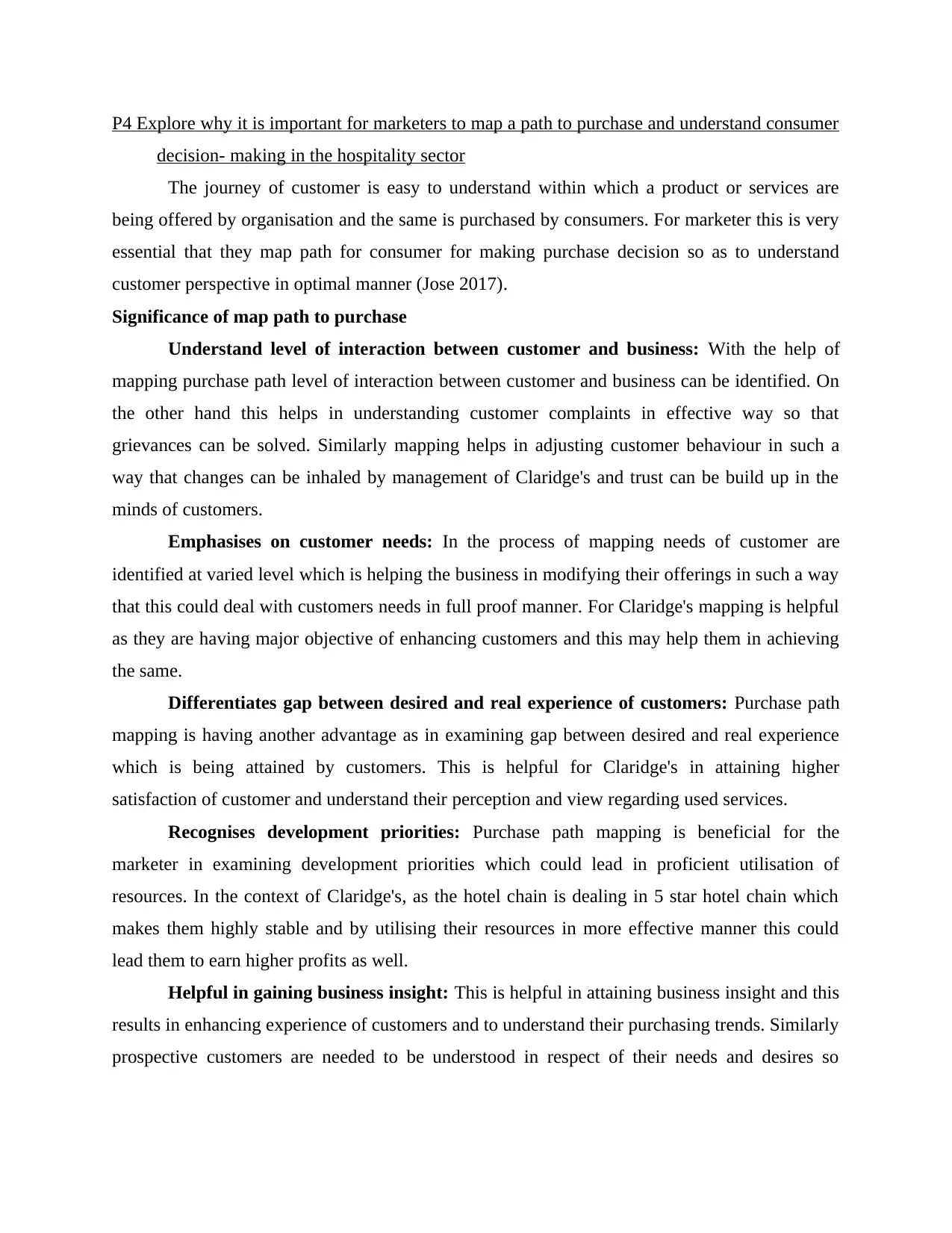
P4 Explore why it is important for marketers to map a path to purchase and understand consumer
decision- making in the hospitality sector
The journey of customer is easy to understand within which a product or services are
being offered by organisation and the same is purchased by consumers. For marketer this is very
essential that they map path for consumer for making purchase decision so as to understand
customer perspective in optimal manner (Jose 2017).
Significance of map path to purchase
Understand level of interaction between customer and business: With the help of
mapping purchase path level of interaction between customer and business can be identified. On
the other hand this helps in understanding customer complaints in effective way so that
grievances can be solved. Similarly mapping helps in adjusting customer behaviour in such a
way that changes can be inhaled by management of Claridge's and trust can be build up in the
minds of customers.
Emphasises on customer needs: In the process of mapping needs of customer are
identified at varied level which is helping the business in modifying their offerings in such a way
that this could deal with customers needs in full proof manner. For Claridge's mapping is helpful
as they are having major objective of enhancing customers and this may help them in achieving
the same.
Differentiates gap between desired and real experience of customers: Purchase path
mapping is having another advantage as in examining gap between desired and real experience
which is being attained by customers. This is helpful for Claridge's in attaining higher
satisfaction of customer and understand their perception and view regarding used services.
Recognises development priorities: Purchase path mapping is beneficial for the
marketer in examining development priorities which could lead in proficient utilisation of
resources. In the context of Claridge's, as the hotel chain is dealing in 5 star hotel chain which
makes them highly stable and by utilising their resources in more effective manner this could
lead them to earn higher profits as well.
Helpful in gaining business insight: This is helpful in attaining business insight and this
results in enhancing experience of customers and to understand their purchasing trends. Similarly
prospective customers are needed to be understood in respect of their needs and desires so
decision- making in the hospitality sector
The journey of customer is easy to understand within which a product or services are
being offered by organisation and the same is purchased by consumers. For marketer this is very
essential that they map path for consumer for making purchase decision so as to understand
customer perspective in optimal manner (Jose 2017).
Significance of map path to purchase
Understand level of interaction between customer and business: With the help of
mapping purchase path level of interaction between customer and business can be identified. On
the other hand this helps in understanding customer complaints in effective way so that
grievances can be solved. Similarly mapping helps in adjusting customer behaviour in such a
way that changes can be inhaled by management of Claridge's and trust can be build up in the
minds of customers.
Emphasises on customer needs: In the process of mapping needs of customer are
identified at varied level which is helping the business in modifying their offerings in such a way
that this could deal with customers needs in full proof manner. For Claridge's mapping is helpful
as they are having major objective of enhancing customers and this may help them in achieving
the same.
Differentiates gap between desired and real experience of customers: Purchase path
mapping is having another advantage as in examining gap between desired and real experience
which is being attained by customers. This is helpful for Claridge's in attaining higher
satisfaction of customer and understand their perception and view regarding used services.
Recognises development priorities: Purchase path mapping is beneficial for the
marketer in examining development priorities which could lead in proficient utilisation of
resources. In the context of Claridge's, as the hotel chain is dealing in 5 star hotel chain which
makes them highly stable and by utilising their resources in more effective manner this could
lead them to earn higher profits as well.
Helpful in gaining business insight: This is helpful in attaining business insight and this
results in enhancing experience of customers and to understand their purchasing trends. Similarly
prospective customers are needed to be understood in respect of their needs and desires so
⊘ This is a preview!⊘
Do you want full access?
Subscribe today to unlock all pages.

Trusted by 1+ million students worldwide
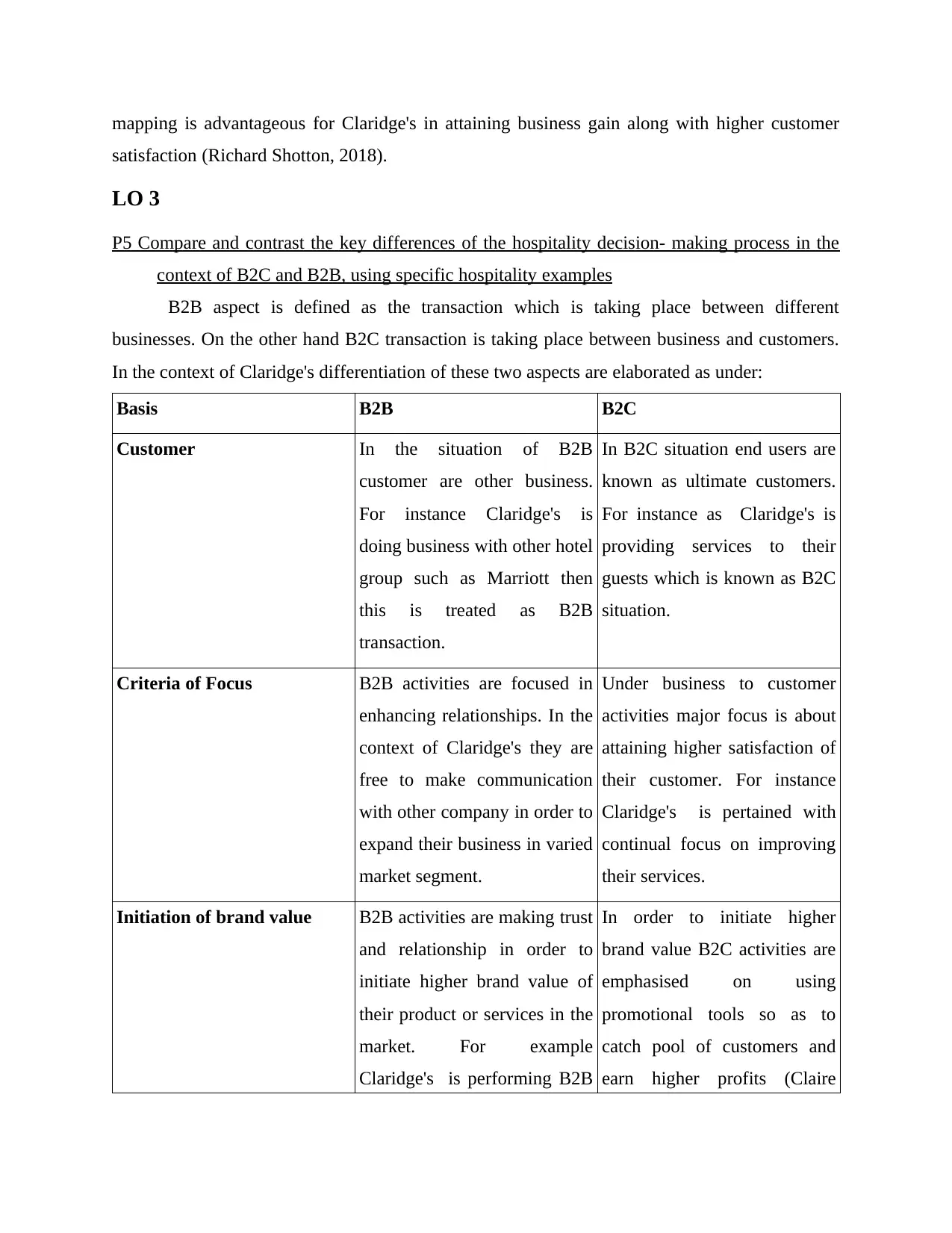
mapping is advantageous for Claridge's in attaining business gain along with higher customer
satisfaction (Richard Shotton, 2018).
LO 3
P5 Compare and contrast the key differences of the hospitality decision- making process in the
context of B2C and B2B, using specific hospitality examples
B2B aspect is defined as the transaction which is taking place between different
businesses. On the other hand B2C transaction is taking place between business and customers.
In the context of Claridge's differentiation of these two aspects are elaborated as under:
Basis B2B B2C
Customer In the situation of B2B
customer are other business.
For instance Claridge's is
doing business with other hotel
group such as Marriott then
this is treated as B2B
transaction.
In B2C situation end users are
known as ultimate customers.
For instance as Claridge's is
providing services to their
guests which is known as B2C
situation.
Criteria of Focus B2B activities are focused in
enhancing relationships. In the
context of Claridge's they are
free to make communication
with other company in order to
expand their business in varied
market segment.
Under business to customer
activities major focus is about
attaining higher satisfaction of
their customer. For instance
Claridge's is pertained with
continual focus on improving
their services.
Initiation of brand value B2B activities are making trust
and relationship in order to
initiate higher brand value of
their product or services in the
market. For example
Claridge's is performing B2B
In order to initiate higher
brand value B2C activities are
emphasised on using
promotional tools so as to
catch pool of customers and
earn higher profits (Claire
satisfaction (Richard Shotton, 2018).
LO 3
P5 Compare and contrast the key differences of the hospitality decision- making process in the
context of B2C and B2B, using specific hospitality examples
B2B aspect is defined as the transaction which is taking place between different
businesses. On the other hand B2C transaction is taking place between business and customers.
In the context of Claridge's differentiation of these two aspects are elaborated as under:
Basis B2B B2C
Customer In the situation of B2B
customer are other business.
For instance Claridge's is
doing business with other hotel
group such as Marriott then
this is treated as B2B
transaction.
In B2C situation end users are
known as ultimate customers.
For instance as Claridge's is
providing services to their
guests which is known as B2C
situation.
Criteria of Focus B2B activities are focused in
enhancing relationships. In the
context of Claridge's they are
free to make communication
with other company in order to
expand their business in varied
market segment.
Under business to customer
activities major focus is about
attaining higher satisfaction of
their customer. For instance
Claridge's is pertained with
continual focus on improving
their services.
Initiation of brand value B2B activities are making trust
and relationship in order to
initiate higher brand value of
their product or services in the
market. For example
Claridge's is performing B2B
In order to initiate higher
brand value B2C activities are
emphasised on using
promotional tools so as to
catch pool of customers and
earn higher profits (Claire
Paraphrase This Document
Need a fresh take? Get an instant paraphrase of this document with our AI Paraphraser
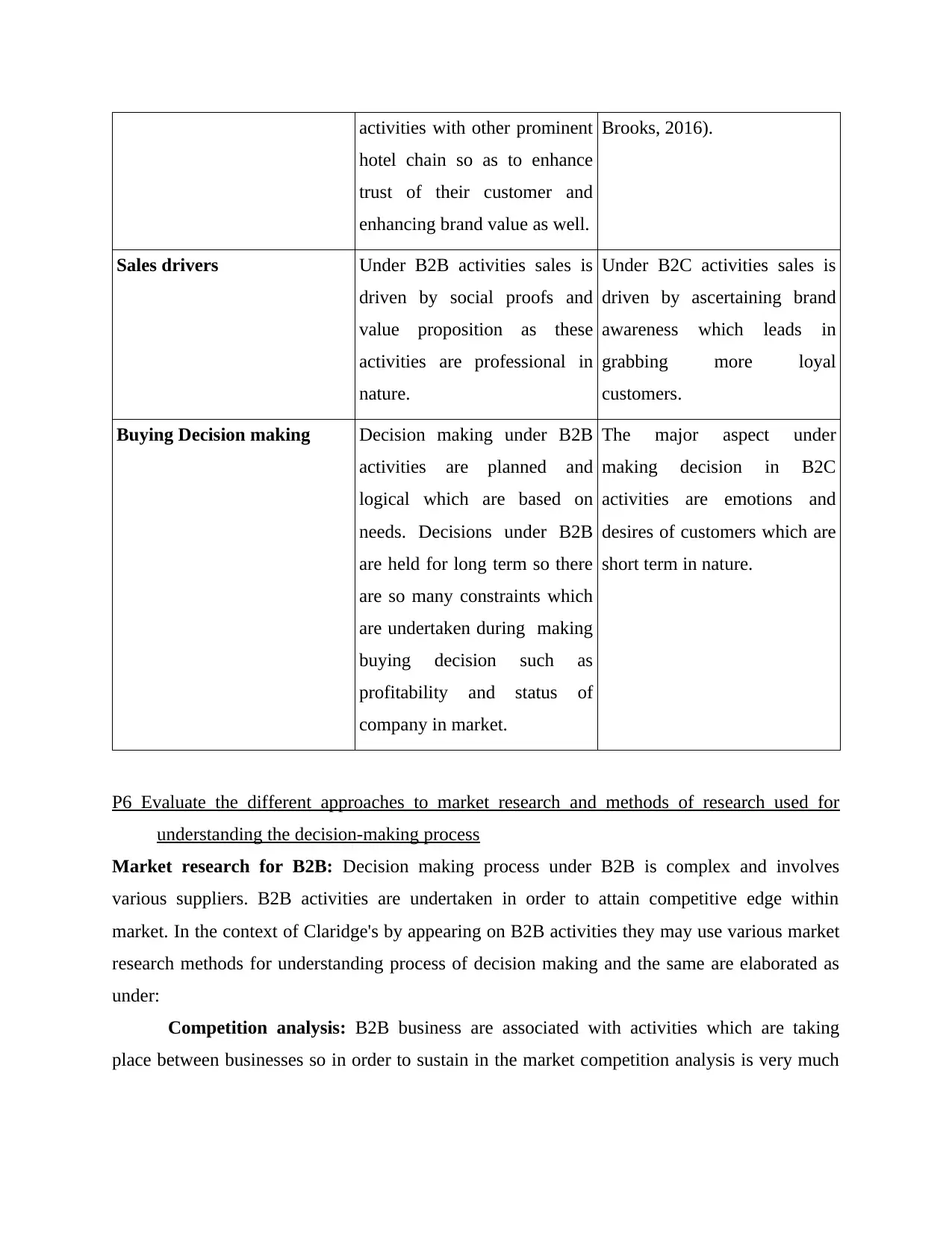
activities with other prominent
hotel chain so as to enhance
trust of their customer and
enhancing brand value as well.
Brooks, 2016).
Sales drivers Under B2B activities sales is
driven by social proofs and
value proposition as these
activities are professional in
nature.
Under B2C activities sales is
driven by ascertaining brand
awareness which leads in
grabbing more loyal
customers.
Buying Decision making Decision making under B2B
activities are planned and
logical which are based on
needs. Decisions under B2B
are held for long term so there
are so many constraints which
are undertaken during making
buying decision such as
profitability and status of
company in market.
The major aspect under
making decision in B2C
activities are emotions and
desires of customers which are
short term in nature.
P6 Evaluate the different approaches to market research and methods of research used for
understanding the decision-making process
Market research for B2B: Decision making process under B2B is complex and involves
various suppliers. B2B activities are undertaken in order to attain competitive edge within
market. In the context of Claridge's by appearing on B2B activities they may use various market
research methods for understanding process of decision making and the same are elaborated as
under:
Competition analysis: B2B business are associated with activities which are taking
place between businesses so in order to sustain in the market competition analysis is very much
hotel chain so as to enhance
trust of their customer and
enhancing brand value as well.
Brooks, 2016).
Sales drivers Under B2B activities sales is
driven by social proofs and
value proposition as these
activities are professional in
nature.
Under B2C activities sales is
driven by ascertaining brand
awareness which leads in
grabbing more loyal
customers.
Buying Decision making Decision making under B2B
activities are planned and
logical which are based on
needs. Decisions under B2B
are held for long term so there
are so many constraints which
are undertaken during making
buying decision such as
profitability and status of
company in market.
The major aspect under
making decision in B2C
activities are emotions and
desires of customers which are
short term in nature.
P6 Evaluate the different approaches to market research and methods of research used for
understanding the decision-making process
Market research for B2B: Decision making process under B2B is complex and involves
various suppliers. B2B activities are undertaken in order to attain competitive edge within
market. In the context of Claridge's by appearing on B2B activities they may use various market
research methods for understanding process of decision making and the same are elaborated as
under:
Competition analysis: B2B business are associated with activities which are taking
place between businesses so in order to sustain in the market competition analysis is very much
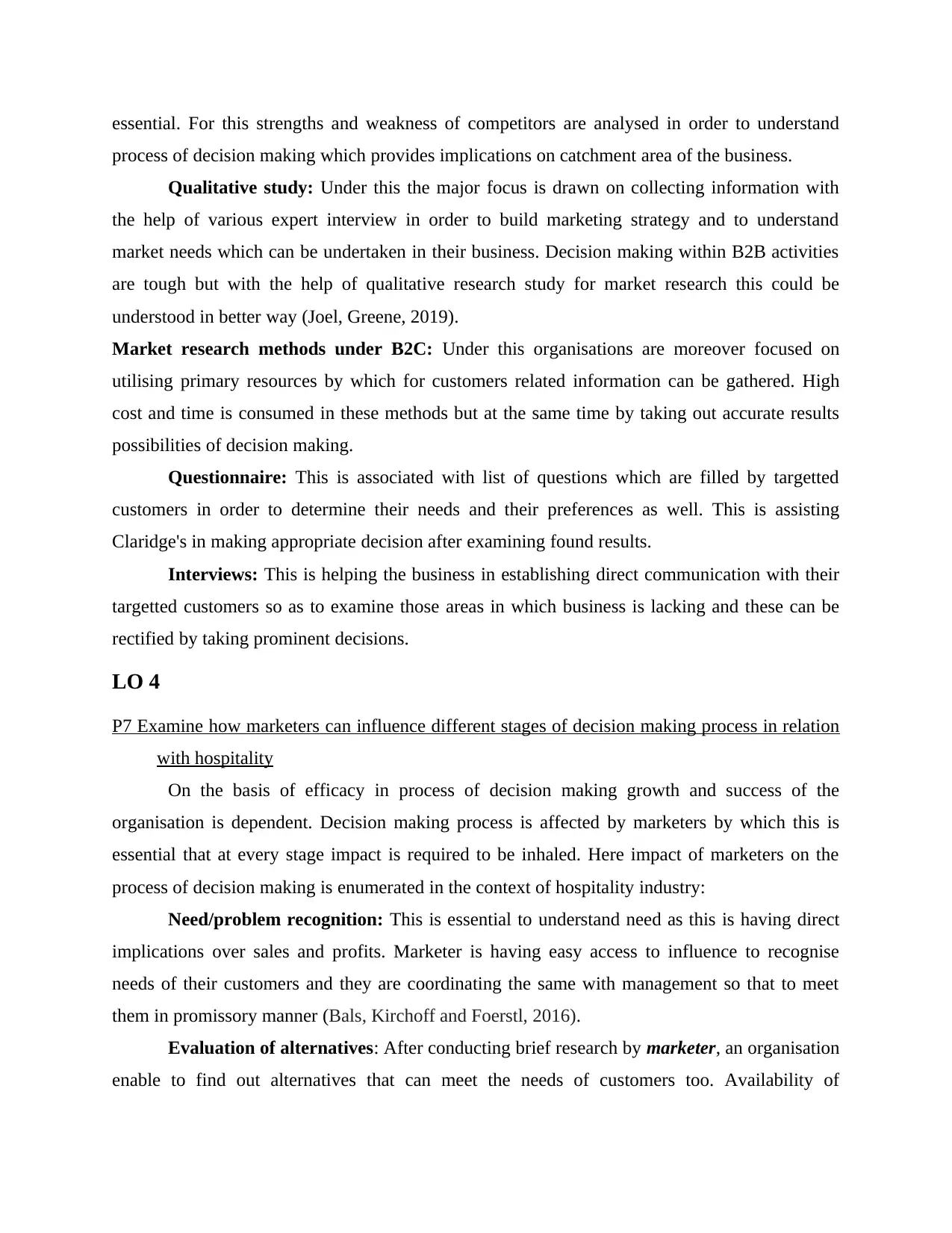
essential. For this strengths and weakness of competitors are analysed in order to understand
process of decision making which provides implications on catchment area of the business.
Qualitative study: Under this the major focus is drawn on collecting information with
the help of various expert interview in order to build marketing strategy and to understand
market needs which can be undertaken in their business. Decision making within B2B activities
are tough but with the help of qualitative research study for market research this could be
understood in better way (Joel, Greene, 2019).
Market research methods under B2C: Under this organisations are moreover focused on
utilising primary resources by which for customers related information can be gathered. High
cost and time is consumed in these methods but at the same time by taking out accurate results
possibilities of decision making.
Questionnaire: This is associated with list of questions which are filled by targetted
customers in order to determine their needs and their preferences as well. This is assisting
Claridge's in making appropriate decision after examining found results.
Interviews: This is helping the business in establishing direct communication with their
targetted customers so as to examine those areas in which business is lacking and these can be
rectified by taking prominent decisions.
LO 4
P7 Examine how marketers can influence different stages of decision making process in relation
with hospitality
On the basis of efficacy in process of decision making growth and success of the
organisation is dependent. Decision making process is affected by marketers by which this is
essential that at every stage impact is required to be inhaled. Here impact of marketers on the
process of decision making is enumerated in the context of hospitality industry:
Need/problem recognition: This is essential to understand need as this is having direct
implications over sales and profits. Marketer is having easy access to influence to recognise
needs of their customers and they are coordinating the same with management so that to meet
them in promissory manner (Bals, Kirchoff and Foerstl, 2016).
Evaluation of alternatives: After conducting brief research by marketer, an organisation
enable to find out alternatives that can meet the needs of customers too. Availability of
process of decision making which provides implications on catchment area of the business.
Qualitative study: Under this the major focus is drawn on collecting information with
the help of various expert interview in order to build marketing strategy and to understand
market needs which can be undertaken in their business. Decision making within B2B activities
are tough but with the help of qualitative research study for market research this could be
understood in better way (Joel, Greene, 2019).
Market research methods under B2C: Under this organisations are moreover focused on
utilising primary resources by which for customers related information can be gathered. High
cost and time is consumed in these methods but at the same time by taking out accurate results
possibilities of decision making.
Questionnaire: This is associated with list of questions which are filled by targetted
customers in order to determine their needs and their preferences as well. This is assisting
Claridge's in making appropriate decision after examining found results.
Interviews: This is helping the business in establishing direct communication with their
targetted customers so as to examine those areas in which business is lacking and these can be
rectified by taking prominent decisions.
LO 4
P7 Examine how marketers can influence different stages of decision making process in relation
with hospitality
On the basis of efficacy in process of decision making growth and success of the
organisation is dependent. Decision making process is affected by marketers by which this is
essential that at every stage impact is required to be inhaled. Here impact of marketers on the
process of decision making is enumerated in the context of hospitality industry:
Need/problem recognition: This is essential to understand need as this is having direct
implications over sales and profits. Marketer is having easy access to influence to recognise
needs of their customers and they are coordinating the same with management so that to meet
them in promissory manner (Bals, Kirchoff and Foerstl, 2016).
Evaluation of alternatives: After conducting brief research by marketer, an organisation
enable to find out alternatives that can meet the needs of customers too. Availability of
⊘ This is a preview!⊘
Do you want full access?
Subscribe today to unlock all pages.

Trusted by 1+ million students worldwide
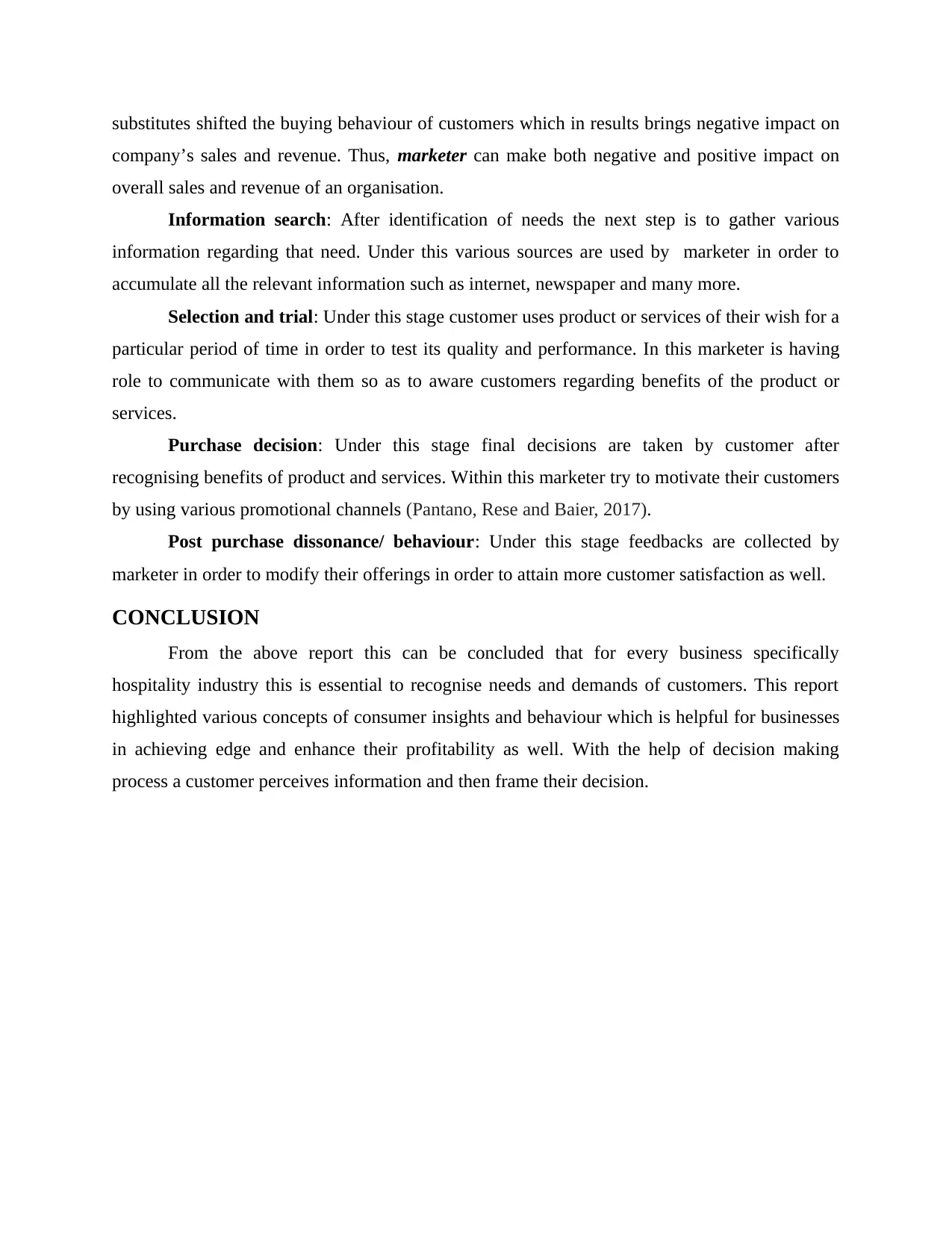
substitutes shifted the buying behaviour of customers which in results brings negative impact on
company’s sales and revenue. Thus, marketer can make both negative and positive impact on
overall sales and revenue of an organisation.
Information search: After identification of needs the next step is to gather various
information regarding that need. Under this various sources are used by marketer in order to
accumulate all the relevant information such as internet, newspaper and many more.
Selection and trial: Under this stage customer uses product or services of their wish for a
particular period of time in order to test its quality and performance. In this marketer is having
role to communicate with them so as to aware customers regarding benefits of the product or
services.
Purchase decision: Under this stage final decisions are taken by customer after
recognising benefits of product and services. Within this marketer try to motivate their customers
by using various promotional channels (Pantano, Rese and Baier, 2017).
Post purchase dissonance/ behaviour: Under this stage feedbacks are collected by
marketer in order to modify their offerings in order to attain more customer satisfaction as well.
CONCLUSION
From the above report this can be concluded that for every business specifically
hospitality industry this is essential to recognise needs and demands of customers. This report
highlighted various concepts of consumer insights and behaviour which is helpful for businesses
in achieving edge and enhance their profitability as well. With the help of decision making
process a customer perceives information and then frame their decision.
company’s sales and revenue. Thus, marketer can make both negative and positive impact on
overall sales and revenue of an organisation.
Information search: After identification of needs the next step is to gather various
information regarding that need. Under this various sources are used by marketer in order to
accumulate all the relevant information such as internet, newspaper and many more.
Selection and trial: Under this stage customer uses product or services of their wish for a
particular period of time in order to test its quality and performance. In this marketer is having
role to communicate with them so as to aware customers regarding benefits of the product or
services.
Purchase decision: Under this stage final decisions are taken by customer after
recognising benefits of product and services. Within this marketer try to motivate their customers
by using various promotional channels (Pantano, Rese and Baier, 2017).
Post purchase dissonance/ behaviour: Under this stage feedbacks are collected by
marketer in order to modify their offerings in order to attain more customer satisfaction as well.
CONCLUSION
From the above report this can be concluded that for every business specifically
hospitality industry this is essential to recognise needs and demands of customers. This report
highlighted various concepts of consumer insights and behaviour which is helpful for businesses
in achieving edge and enhance their profitability as well. With the help of decision making
process a customer perceives information and then frame their decision.
Paraphrase This Document
Need a fresh take? Get an instant paraphrase of this document with our AI Paraphraser
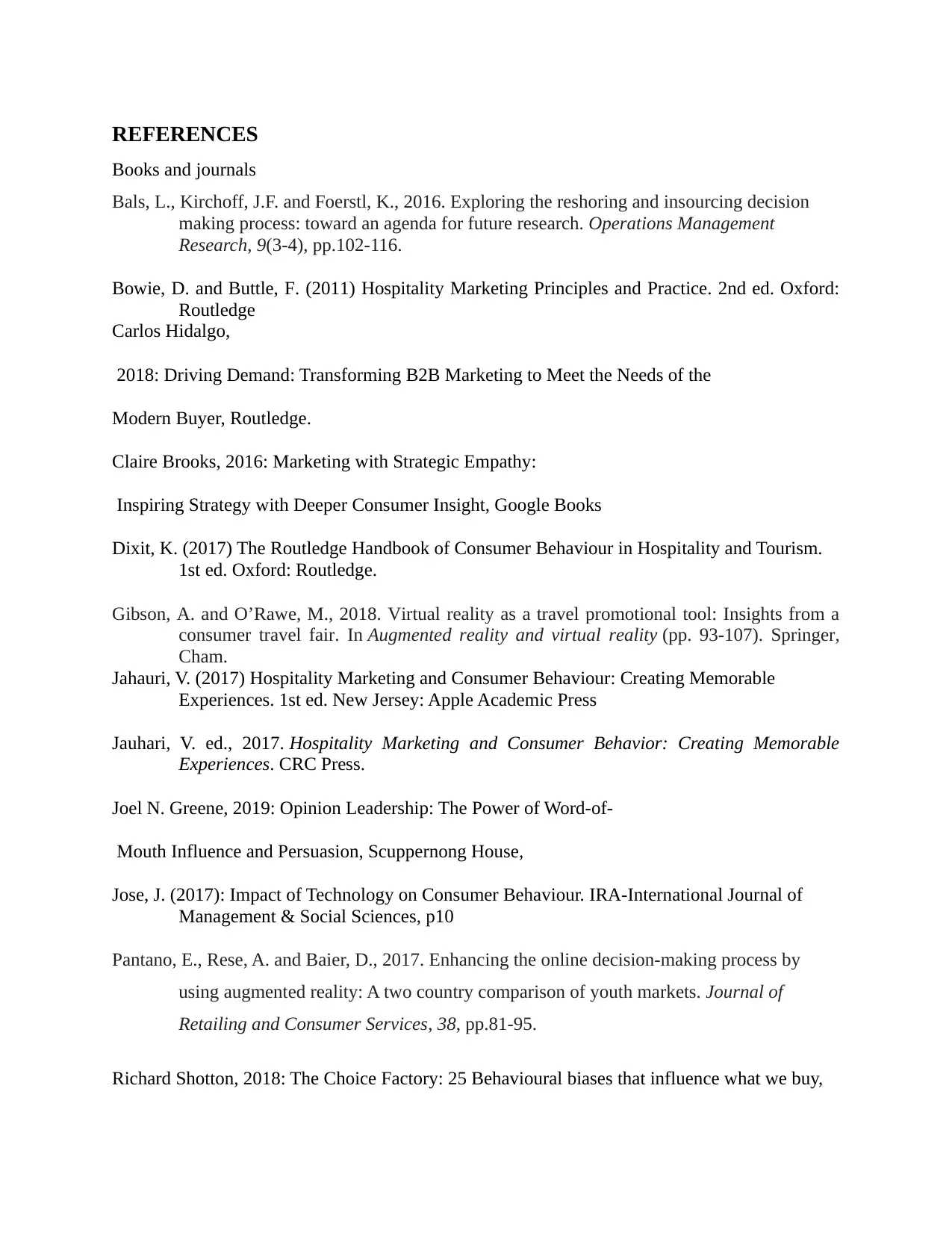
REFERENCES
Books and journals
Bals, L., Kirchoff, J.F. and Foerstl, K., 2016. Exploring the reshoring and insourcing decision
making process: toward an agenda for future research. Operations Management
Research, 9(3-4), pp.102-116.
Bowie, D. and Buttle, F. (2011) Hospitality Marketing Principles and Practice. 2nd ed. Oxford:
Routledge
Carlos Hidalgo,
2018: Driving Demand: Transforming B2B Marketing to Meet the Needs of the
Modern Buyer, Routledge.
Claire Brooks, 2016: Marketing with Strategic Empathy:
Inspiring Strategy with Deeper Consumer Insight, Google Books
Dixit, K. (2017) The Routledge Handbook of Consumer Behaviour in Hospitality and Tourism.
1st ed. Oxford: Routledge.
Gibson, A. and O’Rawe, M., 2018. Virtual reality as a travel promotional tool: Insights from a
consumer travel fair. In Augmented reality and virtual reality (pp. 93-107). Springer,
Cham.
Jahauri, V. (2017) Hospitality Marketing and Consumer Behaviour: Creating Memorable
Experiences. 1st ed. New Jersey: Apple Academic Press
Jauhari, V. ed., 2017. Hospitality Marketing and Consumer Behavior: Creating Memorable
Experiences. CRC Press.
Joel N. Greene, 2019: Opinion Leadership: The Power of Word-of-
Mouth Influence and Persuasion, Scuppernong House,
Jose, J. (2017): Impact of Technology on Consumer Behaviour. IRA-International Journal of
Management & Social Sciences, p10
Pantano, E., Rese, A. and Baier, D., 2017. Enhancing the online decision-making process by
using augmented reality: A two country comparison of youth markets. Journal of
Retailing and Consumer Services, 38, pp.81-95.
Richard Shotton, 2018: The Choice Factory: 25 Behavioural biases that influence what we buy,
Books and journals
Bals, L., Kirchoff, J.F. and Foerstl, K., 2016. Exploring the reshoring and insourcing decision
making process: toward an agenda for future research. Operations Management
Research, 9(3-4), pp.102-116.
Bowie, D. and Buttle, F. (2011) Hospitality Marketing Principles and Practice. 2nd ed. Oxford:
Routledge
Carlos Hidalgo,
2018: Driving Demand: Transforming B2B Marketing to Meet the Needs of the
Modern Buyer, Routledge.
Claire Brooks, 2016: Marketing with Strategic Empathy:
Inspiring Strategy with Deeper Consumer Insight, Google Books
Dixit, K. (2017) The Routledge Handbook of Consumer Behaviour in Hospitality and Tourism.
1st ed. Oxford: Routledge.
Gibson, A. and O’Rawe, M., 2018. Virtual reality as a travel promotional tool: Insights from a
consumer travel fair. In Augmented reality and virtual reality (pp. 93-107). Springer,
Cham.
Jahauri, V. (2017) Hospitality Marketing and Consumer Behaviour: Creating Memorable
Experiences. 1st ed. New Jersey: Apple Academic Press
Jauhari, V. ed., 2017. Hospitality Marketing and Consumer Behavior: Creating Memorable
Experiences. CRC Press.
Joel N. Greene, 2019: Opinion Leadership: The Power of Word-of-
Mouth Influence and Persuasion, Scuppernong House,
Jose, J. (2017): Impact of Technology on Consumer Behaviour. IRA-International Journal of
Management & Social Sciences, p10
Pantano, E., Rese, A. and Baier, D., 2017. Enhancing the online decision-making process by
using augmented reality: A two country comparison of youth markets. Journal of
Retailing and Consumer Services, 38, pp.81-95.
Richard Shotton, 2018: The Choice Factory: 25 Behavioural biases that influence what we buy,
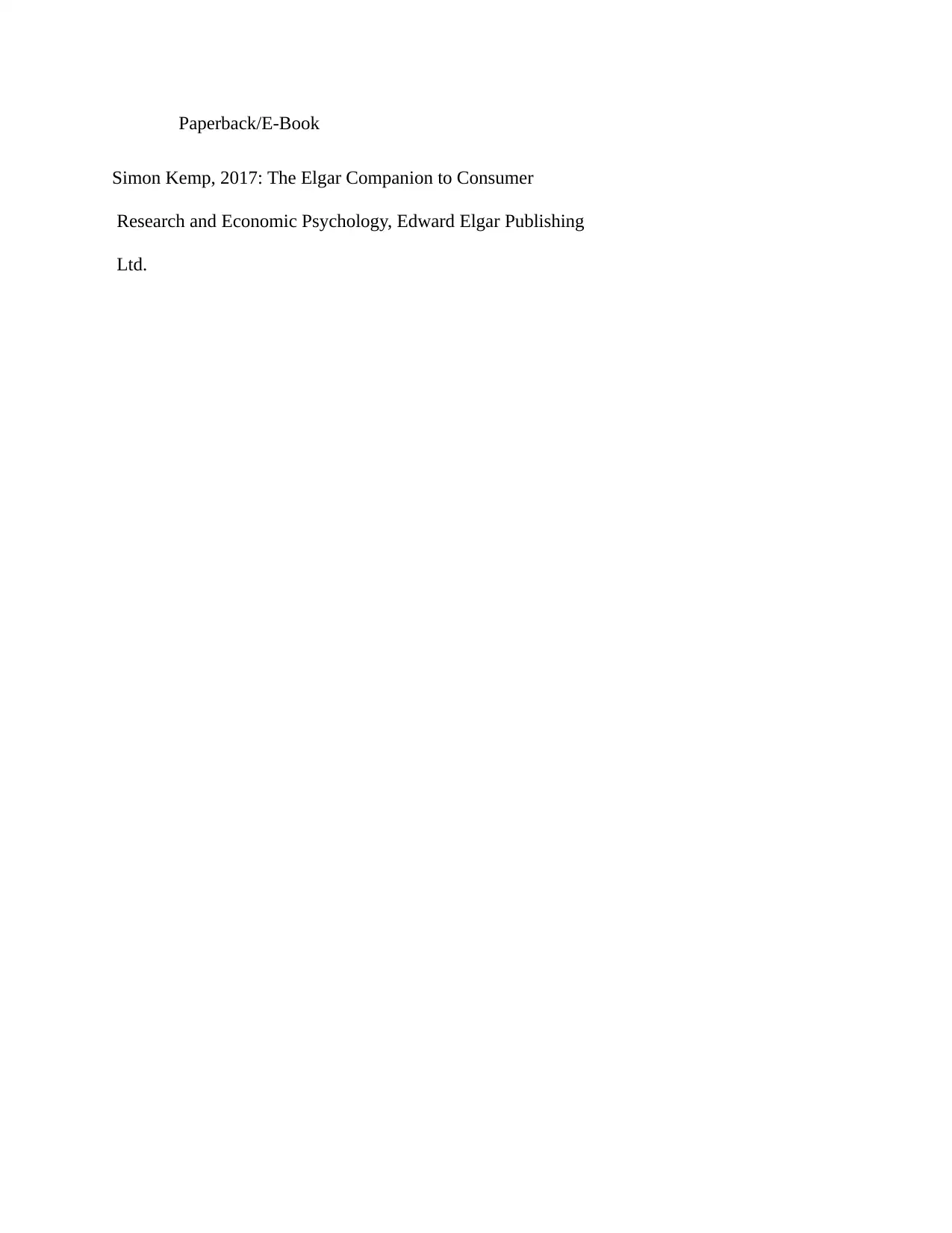
Paperback/E-Book
Simon Kemp, 2017: The Elgar Companion to Consumer
Research and Economic Psychology, Edward Elgar Publishing
Ltd.
Simon Kemp, 2017: The Elgar Companion to Consumer
Research and Economic Psychology, Edward Elgar Publishing
Ltd.
⊘ This is a preview!⊘
Do you want full access?
Subscribe today to unlock all pages.

Trusted by 1+ million students worldwide
1 out of 12
Related Documents
Your All-in-One AI-Powered Toolkit for Academic Success.
+13062052269
info@desklib.com
Available 24*7 on WhatsApp / Email
![[object Object]](/_next/static/media/star-bottom.7253800d.svg)
Unlock your academic potential
Copyright © 2020–2025 A2Z Services. All Rights Reserved. Developed and managed by ZUCOL.




